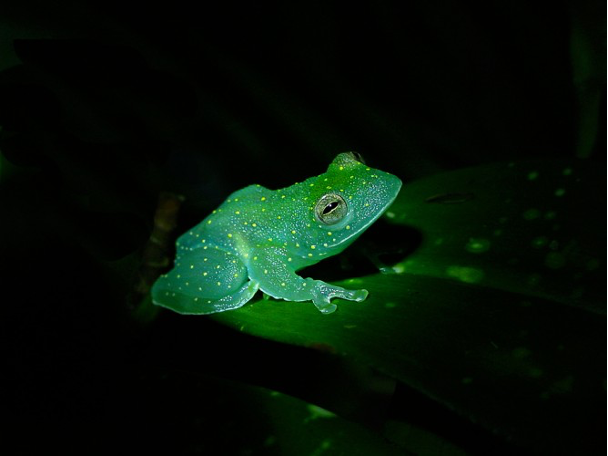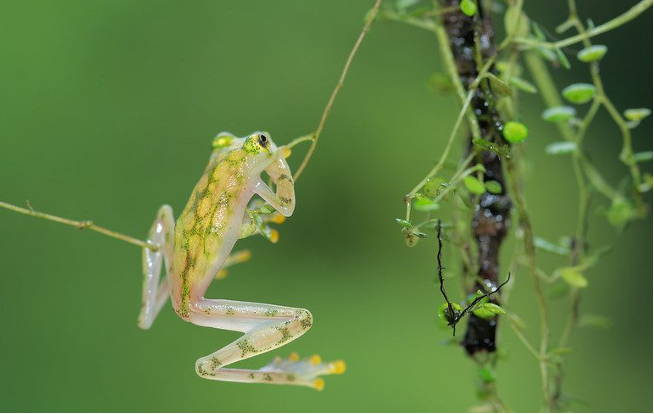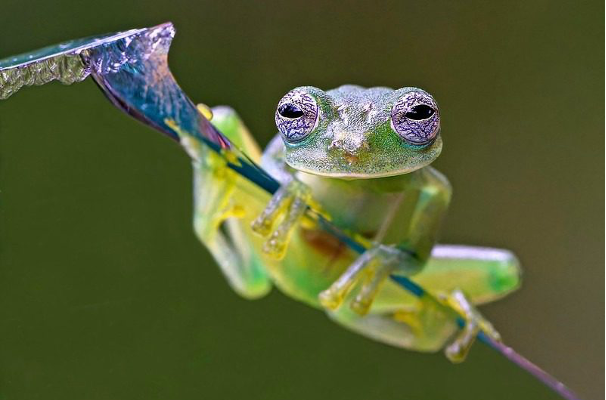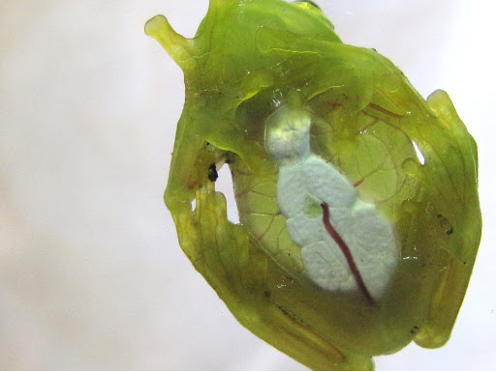Invisible on the Leaf - Hidden Lives of Glass Frogs

Transparency is rare and really hard to achieve because our tissues are full of molecules that absorb and scatter light – such as the pigment melatonin that protect us from UV radiation by making tissues darker; haemoglobin absorbing blue and green light to reflect the red blood colour; along with structural elements of dense tissues. Imagine a creature so transparent that you can watch its heart beat beneath its skin. Meet the glass frog – a tiny amphibian whose translucent belly and chest reveals its hidden world of infrastructures.
I will lead you through the ways that these tiny dwellers achieve their transparency, one of which could advance our understanding of blood clotting!

(Note – read from the section Camouflage Through Translucency if you want to skip information on glass frog lifestyle, mating, and parental care)
Glass Frog Profile
Glass frogs fall within 12 different genera and are all members of the amphibian family Centrolenidae, so far we have identified around 160 of them and some of them are smaller than a paper clip! These delicate frogs inhabit the rainforests and mountainous forests across Central and South America, where the constant humidity lets them stay close to water for breeding. Glass frogs are powerful bioindicators, signaling biodiversity in their forest home. During dry season, they stay high in the canopy, but when the rains return, which is the mating season, they descend to the lower leaves above flowing streams to being their courtship.

Evening Ritual
When night falls over the rainforest, the forest hums to life. As nocturnal creatures, this is when the glass frogs begin their nightly ritual. Males climb onto leaves that dangle above rushing streams and begin to sing, their high-pitched calls ripple through the darkness to summon nearby females. When one arrives, he embraces her tightly — a ritual known as amplexus — and fertilizes her eggs as she lays them. The tiny pearls cling to the underside of the leaf, glistening with life. Depending on the species, one or both parents will stand guard: females may keep watch through the night, while devoted males often remain long after, fending off predators and keeping the eggs moist. When the time comes, the tadpoles wriggle free and drop into the stream below, where they’ll drift and grow for nearly ten months before transforming into adults that can live up to 14 years.
By day, these frogs vanish almost completely. Resting on the leaves, they enter a super-camouflaged state, with their green skin and transparent bellies blending seamlessly with the forest canopy. Studying them is no easy task – scientists must stay awake during the night, just like the glass frogs, to glimpse their hidden world.
A mention on behavioural ecology
Prime location alone is rarely enough to attract a female. Observations show that males sometimes linger beside abandoned clutches of eggs for hours, pretending to guard them. This clever strategy tricks the female voyeurs, who are tricked into thinking the male is an experienced father, increasing his chance of mating. Such behaviors shows the dynamic interplay between male signaling, territory selection, parental behaviour, and female choice in glass frog courtship, revealing just how sophisticated amphibian interactions can be.
Evolutionary lens
When the first glass frogs evolved some 25 million to 35 million years ago, female frogs likely did all the parenting work. While progressing to around 8 million years, some males took over parenting. By now, the father usually provide longer and more diverse care than the mother, who sometimes abandon their eggs well before they are ready to hatch, which could be because they were focused on making more eggs to carry on their genes.

Camouflage Through Translucency
In nature, transparency is largely reserved for fully aquatic creatures such as gelatinous jelly fish. It is a much tougher task for terrestrial animals (glass frogs) to turn clear because light reflects differently through air than water.
In glass frogs, their viscera (internal organs) are visible, if you look from the ventral (belly) side, you can see the heart pumping blood into the arteries and food moving through the gut. Their lateral (side) and dorsal (top) sides are exposed to predators while they rest, therefore contains concentrated green pigmentation that acts like a filter, shielding these thick and complex body tissues from view, and potentially from harmful UV radiation.
As masters of camouflage, green frogs are less likely to be attacked by wild predators than opaque frogs. Their translucency is achieved by adjusting intensity of light as they pass through glass frogs’ body to match the tone of leaves they rest on, changing perceived luminance. For example, if a glass frog rests on a dark green leaf, it would look darker because less light is passed through its body and are reflected off its skin. Unlike full transparency, their green pigmentation is maintained, therefore the frogs would appear green at all times but can brighten or darken depending on the substrate against which they are viewed.
The fact that glass frogs cannot become fully transparent might be seen as a limitation for its camouflage nowadays; however, the glass frogs’ natural history provides an explanation that bridges the potential efficacy gap between translucency and transparency. Under natural conditions, they remain perfectly still during daylight, resting on green leaves with their legs tucked to the sides of their body. This provides them a background that does not include complex visual textures, reducing the need to dynamic pattern matching; meanwhile, green pigmentation provides the general base colour which is calibrated by light transmission.
An interesting adaptation in glass frogs’ camouflage ability is that their legs have a greater change in perceived luminance, and remains relatively more see through than the body. As mentioned above, they tuck their legs to the sides of the body while resting, which act as a diffusion gradient between the substrate (leaves) and the dorsal (body) colour, creating a more gradual and low contrast colour transition that blends the frog and the leaf more smoothly together. As visual systems are particularly sensitive to high contrast edges, especially in the luminance domain, this ‘edge diffusion’ significantly reduces their detectability from predators sensitive to sharp, visual boundaries.

Hiding the Red – the red blood cell phenomenon
As mentioned in the introduction, protein hemoglobin absorbs blue and green light to reflect the crimson colour of red blood cells, keeping our skin opaque. To discover how glass frogs overcome this hurdle, scientists studied the transparency of Fleischmann’s glass frogs using the imaging technique photoacoustic microscopy, which maps the ultrasound waves produced when red blood cells absorb light. It was found that at night, there is a lack of red blood cells travelling through the veins; conversely, during the day when they sleep, glass frogs were able to store 89% of red blood cells in their liver for camouflage, increasing liver size by 40%; This is exceptionally high compared with other tree frogs which can only store around 12% of red blood cells in their liver. It was also detected that sleeping glass frogs has an average of 96.6% less oxygenated hemoglobin in circulation, which together indicates the lack of oxygen circulation during sleep, participating for a long period of time every day. This is hard to explain in terms of the constant need of aerobic respiration.
Excessive red blood cell accumulation in humans can block blood vessels and potentially lead to fatal conditions; therefore, an important question that arises from this is how glass frogs are able to move so many blood cells into one location without creating a fatal blood clot. They are able to condense and expand their red blood cells in any way they want without any negative effects, which indicates that they have a different working biological mechanism, able to prevent both excessive bleeding and clotting.
Conclusion
The ways in which glass frogs survive this extreme adaptation of red blood cell transport is unclear. In addition to findings so far about ways that glass frogs keep their transparency of muscles and internal structures, there might be more adaptations for achieving transparency, such as by allowing light to travel in the same, straight trajectory, thereby scattering light in with minimal angles, reducing opacity.